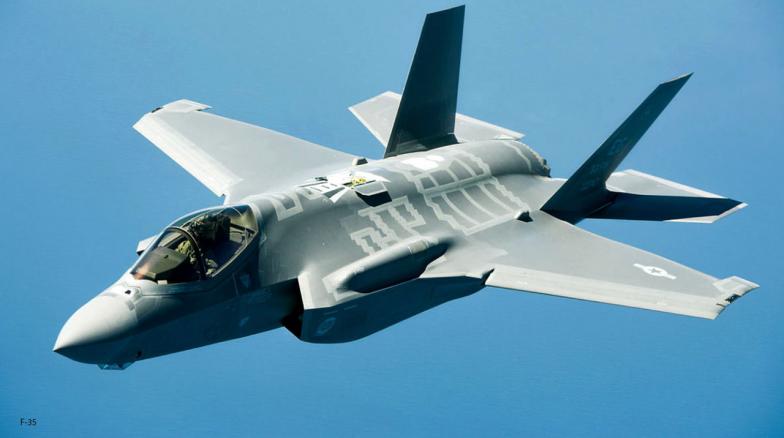Cybersecurity is an evolving market, and organizations are always advised to keep their network armed and secured against cybercriminals. Considering the recent sophisticated cyberattacks, Airforce is one key area to explore.
US Cyber Command along with NSA does have a competitive cybersecurity advantage in the global market of cybersecurity. The United States is additionally one among the top five countries in the cybersecurity industry.
Lockheed martin’s F-35 the stealth fighter jets is nearing its production with advanced computing technologies and frameworks.
F-35 can evade the radars be stealthy and execute missions in absolute silence, they will be in and out of an area before you can even discover it in radar.
However, their advanced computing technologies could become vulnerable to hackers if they are not properly secured and updated.
F-35 can only be operated after pilots feed the unique PIN numbers and mission authentication codes into their cockpits, which means the hackers will not be able to breach into the fighter systems easily.
Pilots have stated, ‘The plane is as much as a computer as a fighter jet’. Just like any device that connects to the internet, F-35 also does connects two off-board programs that aid in entire logistics, planning, maintenance, training, and support.
With this connection to the external environment, apart from the cockpit, F-35 jets can be interrupted by hackers using the above mentioned two off-board programs.
The two programs are:
- Autonomic Logistics Information System (ALIS)
- Joint Reprogramming Enterprise (JRE)
How Could Hackers Possibly Penetrate F-35 Tech?
The worldwide fleet of F-35 is connected to these programs through the country centric point and then to the Lockheed martin servers.
ALIS is used for tracking the individual aircraft’s issues and spare parts.
To improve the performance of the jets, Lockheed’s central server which records most of the data that is happening with every individual F-35 fighter around the world.
This ALIS server is compact and can be set up even inside a small container to analyze all the data that is flowing from the fighter jets.
This ALIS server could be a sweet spot for hackers, as a breach into this server can give access to an enormous amount of confidential information allowing them to take control of all the data that would be fed into the aircraft in the future.
An outdated program or a remote code execution capabilities exploiting any new zero-day flaws or using malware can become hazardous to F-35 fighter jets.
Military and Lockheed need to tighten their firewalls, continuously monitor the incoming traffic using honeypots and ensure everything is in line against cyberthreats.
JRE takes of sensors and weapon system which is being distributed to the F-35 across the world.
JRE is also used for automatically sharing the radar and other digital information pertaining to electronic warfare signals rather than analyzing the same manually.
This information can be crucial for F-35 missions to keep the pilots informed about their combat metrics, location, maneuvers and attack strategies.
Both these programs and their networks definitely have a high-end cybersecurity framework and practices.
However, cybercriminals are always keen to take down critical infrastructures for confidential military or business information, disrupting the normal logistics, or spare part management and planning.
it is not only about retrieving information, at times hackers can even drop in some extra information to confuse or hinder the overall performance.
For example, A update on demand for more F-35 engines could create a substantial amount of confusions and productivity breaks.
However, in combats, hackers can interrupt these ALIS and JRE systems to feed wrong data on their missions.
For example, A fake update on mission instructions like fly time, directions, distance to target and target engage norms could result in confusions leading to poor execution. Not only ALIS or JRE, but even the F-35 simulators can also be a source for a lot of confidential information.
Breach into military data can threaten critical, as the hackers would have breached a high-security zone and retrieve the delicate data.
Best practices to reinforce cybersecurity for
Considering the level of cybersecurity already existing within the military, this section will be a checklist for the security professionals.
- Making sure your programs and applications are up-to-date across geographical locations.
- ALIS and JRE vulnerabilities have to be fixed and released in the least amount of time, leaving no opportunities for hackers.
- Employing honeypot in your network to nullify cyber threats, keeping communications between the F-35 fleet and central server connections secured and safe.
- Data protection frameworks, identifying and removing the unwanted or expired data inside your databases could save you from unforeseen data breaches.
- Equipping a unified device management approach to manage even your roaming devices, monitoring and controlling the military data flow could be beneficial.
- Taking care of remote devices, by troubleshooting, multi-monitoring, shadowing, blackening user devices could improvise the efficiency.
- Managing browser and firewall configurations could enrich your endpoint management routines.
ALIS and JRE could be the cases for F-35 in particular, but securing similar programs that are used in back-end with other fighter jets could keep them vigilant against cyberattacks.







